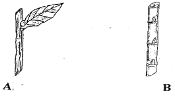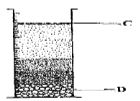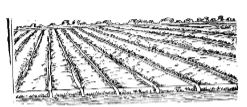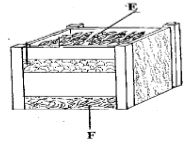Questions
INSTRUCTION TO CANDIDATES
- This paper consists of THREE sections: A, B and C.
- Answer ALL questions in section A.and B
- ANY Two questions from section C.
SECTION A (30MKS)
Answer all the questions from this section in the spaces provided.
- Give two characteristics of plantation farming. (1mk)
- Name two chemical processes of weathering. (1mk)
- State two advantages of organic farming. (1mk)
- Outline two effects of soil organisms which benefit plant growth. (1mk)
- Give two ways in which organic mulch help to conserve water in the soil. (1mk)
- Give two types of labour records. (1mk)
- Outline four ways in which land consolidation helps to improve farm management. (2mks)
- State four importance of raising seedlings in a nursery bed. (2mks)
- Give four ways of controlling weeds in a field of maize. (2mks)
- State three reasons for top dressing pasture. ( 11/2mks)
- Give four reasons for training crops as a field practice . ( 2mks)
- State three activities the farmer carries out on a store before storing grains. (11/2mks)
- Give four desirable characteristics of certified seeds. (2mks)
-
- Outline two characteristics of nitrogenous fertilizers. (1mk)
- Give the forms in which the following elements are available to plants: (1mk)
- Phosphorous: ……………………………………….
- Potassium: ………………………………………
- Give four factors that influence the choice of tools and equipment used in Primary cultivation. (2mks)
- State four factors that contribute to competitive ability of weeds. (2mks)
- Define the following terms as used in crop production.
- Trelishing (1mk)
- Stooking (1mk)
- Give two advantages of strip grazing (1mk)
- State four advantages of mixed pasture. (2mks)
SECTION B. (20 MARKS)
Answer ALL questions in this section in the spaces provided
- Study the diagram below and answer the questions that follow. The illustrations represent a method of crop propagation.
- Name the crops (s) propagated by illustrations: (1mrk)
- Give three factors that promote the rooting of illustration A. (3mrks)
- The diagram below illustrates an experiment using garden soil. Study it carefully and answer the question that follow.
- What was the aim of the experiment? (1mrk)
- Name the parts labeled C and D. (2mrks)
- Name the property of soil being investigated. (1mrk)
- The illustration below shows a type of soil erosion. Study it carefully and answer the questions that follow.
- Identify the type of erosion illustrated. (1mrk)
- Give two soil factors that influence the rate of soil erosion. (2mrks)
- Name one agent of soil erosion. (1mrk)
- The diagram below illustrate a method of irrigation carried out on the farm
- Identify the type of irrigation shown above. (1mk)
- Name two advantages of the above method. (2mks)
- The diagram below represent a method of manure preparation. Study it carefully and answer the questions that follow.
- Identify the type of manure being prepared. (1mrk)
- Name the parts labeled E and F. (1mrk) .
E
F - Give three disadvantages of manures. (3mrks)
SECTION C (40MARKS)
Answer any TWO question from the section in the spaces provided
-
- Give six precautions observed in pruning mature tea (6 mks)
- Describe the procedure followed when collecting a soil sample form the field for testing in the laboratory (6 mks)
- Outline four advantages of intercropping crops (4 mks)
- State four factors considered before selecting a farm enterprise. (4 mks)
- Describe the production of tomatoes under the following sub-headings:
- Ecological requirements of tomato plants (5mks)
- Land preparations (4mks)
- Transplanting (7mks)
- Disease control (4mks)
-
- State five factors that influence soil productivity. (5mks)
- State five qualities of mother plant used during grafting. (5mks)
- Give two types of mulching materials. (2mks)
- State four agricultural practices which pollute water. (4mks)
- Describe precautions followed when harvesting coffee. (4mks)
Marking Scheme
- Give two characteristics of plantation farming (1 mark)
- Production of one type of crop
- Require large tract of land
- Name two chemical processes of weathering
- Carbonation
- Oxidation
- Hydration
- State two advantages of organic farming (1 mk)
- Improves soil structure
- Enhance soil water infiltration and retention
- Provides food for soil microbes
- Production of food free from chemical residues
- Cheaper since there is purchase and chemicals
- Outline three effects of soul organisms which benefit plant growth (1 mark)
- Improves aeration
- Release soil nutrients when they decompose
- Help in decomposition process
- promote nitrogen fixation .
- Give two ways in which organic mulch help to conserve water in the soul (1 mark)
- Reduce water loss through evaporation
- Improve soil water infiltration and retention
- Give two types of labour records
- Labour utilization analysis
- Muster roll
- Outline four ways in which land consolidation helps to improve farm management (2 marks)
- Proper supervision
- Saves time and transportation cost
- Facilitator soil conservation and farm mechanization
- Legal ownership and title deed used to secure loans
- State four importance raising seedlings in a nursery bed (2mks)
- Excess sold for income
- Facilitates planting of small seeds
- Production of many seedlings in small area
- Management practices easily and timely carried out
- Transplanting of only healthy and vigorously growling
- provide best condition for growth of seedlings.
- Give four ways of controlling weeds in a field of maize
- Uprooting
- Cultivation/ weeding with a jembe
- Use of herbicides rej chemical method
- Slashing weeds
- State three reasons for top dressing pasture (1 ½ mks)
- Increase herbage yields
- Improve nutritive value of crop
- Add soil nutrients
- Give four reasons for training crops as a field practice (2 marks)
- Plants grow in a designed direction and shape
- Facilitates easy harvesting and spraying
- Clean fruits are produced
- Support plants
- State three activities the farmer carries out on a store before storing grains
- Cleaning the store/remove debris of previous crops
- Dusting
- Higher germination percentage
- Pure/true to type
- Give four desirable characteristics of certified seeds. (2mks)
- High yielding
- pure/True to type
- Clean/freeeeds
- High germination percentage
- Healthy/free from pests and diseases
-
- Outline two characteristics of nitrogenous fertilizers
- Highly soluble
- Easily leached
- Scorching /burning effects
- Highly volatile
- Hygroscopic
- Give the forms in which the following elements are available to plants (1 mk)
- Phosphorous: Phosphate ions (PO42)
- Potassium: Potassium ions (K+)
- Outline two characteristics of nitrogenous fertilizers
- Give four factors that influence the choice of tools and equipment used in Primary cultivation. (2 marks)
- Condition of the land
- Type of tilth required
- Depth of cultivation
- Availability /cost of the tool
- State four factors that contribute to competitive ability of weds (2 mks)
- Produce large quantities of seeds
- Seeds remain viable for long
- Ability to propagate vegetative
- Seeds easily and successfully dispersed
- Ability to grow in poor soil condition.
- Terms;
- Trellishing
- supporting climbing plants e.g passion fruits (1mk)
- Stooking
- cutting maize and arranging it vertically in groups in the field (OWTTE) (1mk)
- Trellishing
- Two advantages of strip grazin
- minimizes chances of animals getting bloat
- gives more productivity per unit area of land
- the pasture is utilized more efficiently
- comparatively cheaper than constructing the paddocks (2 x ½ = 1mk)
- Four advantages of mixed pasture
- security against total loss due to pest and disease attack
- high nutrient value and high yields
- lasts longer than pure stand pasture
- maximum use of nutrients.
- better ground cover and better weed control
- economy on the use of nitrogen fertilizer (4 x ½ = 2mks)
-
-
- A = Tea
- B = sugarcane 2 x ½ = (1mk)
-
- Oxygen supply
- Rooting medium
- Correct relative humidity
- Suitable temperature
- Suitable light intensity
- Leaf area 3 x 1 = (3mks)
-
-
- To show that soil is made of different sized particles (1 x 1= 1mk)
-
- C= Humus / organic matter.
- D = Gravel . 2 x 1 = (2mks)
- Soil texture 1x1 = (1mk)
-
- Splash / Rain drop
1 x1 = 1mk -
- Soil depth / profile
- Soil type 2 x 1 = (2mks)
-
- Wind
- Water
- Human activities
- Splash / Rain drop
-
- Furrow irrigation 1x1 =1mk
-
- Reduce fungal diseases eg blight
- Cheap to establish & maintain
- Require little skills. 2x1=2mks
-
- Compost manure 1x1 =(1mk)
-
- E = Dry leaves
- F = Maize stalk 2 x ½ = ( 1mk)
- disadvantages of manure
- Release nutrients slowly
- Bulky
- May be a source of weeds
- Provide breeding ground for pests
- Difficult to quantify nutrients contained 3 x 1 = (3mks)
- Can only be used if fully decomposed.
-
- Give six precautions observed in pruning mature tea (6 mks)
- Side branches should never be out to encourage spread of tea bush
- Avoid dish-shaped frame
- Prune parallel with slope of ground not horizontal
- Cut branches across to minimise area of wound
- Pruning knife should be sharp
- Small branches and twigs on frame be removed by hand
- Leave branches to rot to release nutrients/act as mulch
- Describe the procedure followed when collecting a soil sample form the field for testing in the laboratory (6 mks - procedural)
- Clear vegetation from sampling spot
- Make vertical act 15-25cm deep (crop land), 5cm pasture
- Take slice with spade/soil auger
- Put soil sample in clean polythene bag
- Repeat the 1-4 steps in 15-20 spots
- Mix sample thoroughly dry and crush
- Take sub-sample /composite sample to laboratory for testing
- Outline four advantages of intercropping crops (4 mks)
- Helps to control soil erosion
- Good ground cover helps to smother weeds
- Maximum utilization of the land
- Add soil nutrients in case legumes are intercropped
- Factors considered before selecting a farm enterprise. (4 mks)
- Land topography / drainage
- Suitability of soil to the enterprise
- Social cultural factors
- Taste / preference of the farmer
- Availability of inputs
- Size of the land available for the enterprise
- The prevailing climate
- Availability of market for the products
- The period enterprise would take to mature
- The current government policy
- The common pests and diseases which may hinder the enterprise when implemented
- Availability of capital
- Land tenure system
- Profit margin in relation to price fluctuation
- Give six precautions observed in pruning mature tea (6 mks)
- Field production of tomatoes
- Ecological requirements of tomato plants
- Rainfall 760 – 1300mm p.a well distributed
- Irrigation in dry areas / dry season
- Attitude 0 – 2100 M a.s.l
- Soil, deep, fertile, well drained soils
- Temperature 180 – 290C / warm
- Soil pH 6 – 6.5 (1 x 5 =5mks)
- Land preparations
- Early land preparations before on set of rains
- Clear all the vegetation
- Remove tree stumps
- Plough deep / primary cultivation
- Harrow the land to medium tilth
- Prepare planting holes 15cm deep
- Spacing to be 0.9 x 0.6m / 1.0m x 0.5m depending on varieties
- Apply organic manure / tea spoonfuls DSP (1 x 4 = 4mks)
- Transplanting
- Done early in the morning or late in the evening
- Water the nursery bed well
- Use a garden trowel to lift the seedlings with a ball of soil around the root
- Select only the healthy and vigorous growing seedlings
- Place each seedling in the planting hole
- Firm / compact the soil around the base of seedlings
- Mulch the seedlings / shade if necessary
- Water the seedlings (7 x 1 =7mks)
- Disease control
- Use appropriate chemical to control disease
- Ensure regular watering to control blossom end rot
- Practice proper field hygiene / rogueing the infected plants
- Plant resistant varieties (4 x 1 = 4mks)
- Ecological requirements of tomato plants
-
- Five factors that influence soil productivity.
- Good supply of crop nutrients.
- Well aerated
- Good drainage
- Abundance of useful soil micro- organisms.
- Adequate water retention.
- Freedom from plant pests and diseases causing organism.
- Free from noxious weeds eg witch weeds.
( 5 x 1 = 5mks)
- Qualities of mother plant
- High yielding
- Resistant to pests / diseases
- High quality produce.
- High rooting ability.
- Early maturing
- should be compatible
( 5 x 1 – 5mks)
- Two types of mulching materials
- organic mulches
- Inorganic/ synthetic mulches
(2x1 = 2mks)
- For agricultural practices which pollute water.
- Use agro – chemicals in the farm lands.
- Cultivating along river banks encouraging soil erosion, flooding and siltation of streams, rivers etc.
- washing farm machines directly in water bodies.
- Over – grazing leading to soil erosion and siltation of water sources.
( stating 1mk Explanation 1mk) ( 4 x 1 = 4mks)
- Precaution when harvesting coffee.
- Over – ripe dark coloured cherries should not be picked.
- Under – ripe / green coloured cherries should not be picked.
- Sort out diseased berries before delivering to the factory to avoid pulping problems.
- Deliver cherries to the processing factory on the day of harvesting.( 4 x 1 = 4mks)
- Five factors that influence soil productivity.
Download Agriculture Paper 1 Questions and Answers - Kapsabet Highschool Mock Exams 2022.
Tap Here to Download for 50/-
Get on WhatsApp for 50/-
Why download?
- ✔ To read offline at any time.
- ✔ To Print at your convenience
- ✔ Share Easily with Friends / Students





